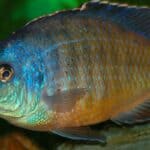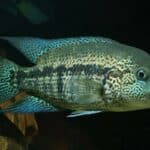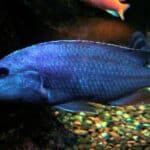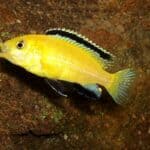Red Devil Cichlids are interesting fish, both in appearance and behaviour. Their uniqueness makes them a very popular fish amongst aquarists.
But while their appearance and activity level makes them appealing fish to have in your tank, they are also feisty fish that are not for the faint-hearted and inexperienced to keep.
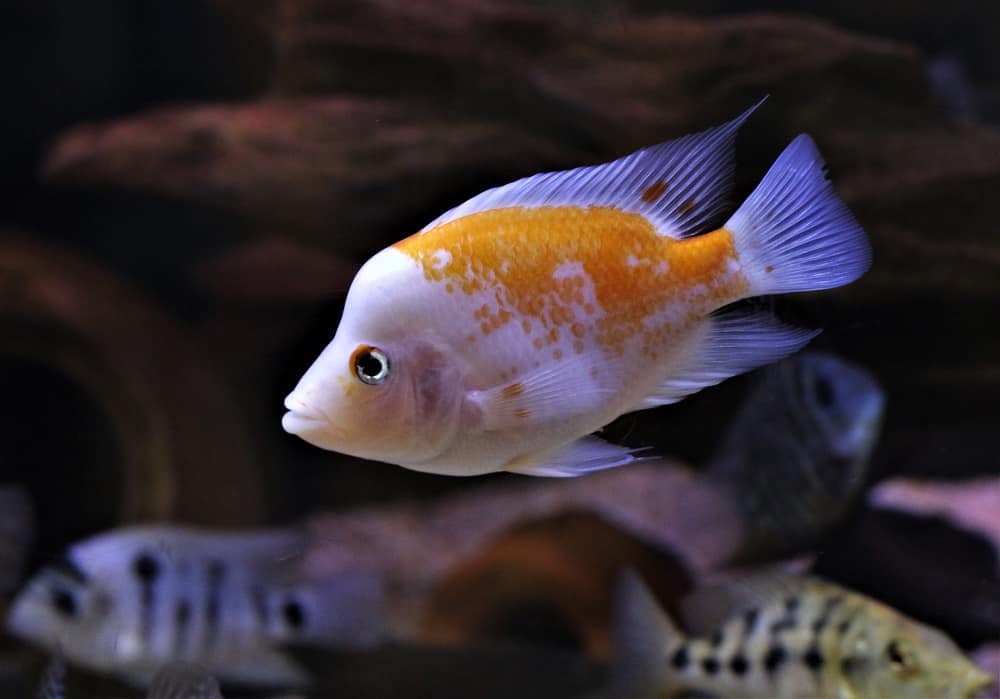
Our guide will tell you everything you need to know about the Red Devil Cichlid and how to care for one so you’ll be prepared if you decide to add one to your tank.
Species Summary
The Red Devil Cichlid (or Amphilophus Labiatus) is a charismatic fish much loved by aquarists. They’re also one of the more loyal species of fish, developing bonds with their owners. They’re sure to put on a show for you, and can even beg for their food like a dog.
However, their name tells you a lot about them. They are certainly a handful! Not only are they aggressive to other fish, but they’re known to destroy anything they can get their teeth into.
Red Devil Cichlids are usually found in Nicaraguan lakes, especially Lake Managua, Lake Nicaragua, and Lake Xiloa. They were classified under the genus Cichlasoma, but they have since been classified under their own genus.
But despite their challenges, their stunning appearance, playfulness, and affectionate nature towards their owners make them a delight to keep.
Care Guide
Tank size: Red Devil Cichlid are large fish, and a single fish will need at least a 55 gallon tank.
If you would like a breeding pair, they will need a tank that’s at least 125 gallons, while for multi-fish tanks you will probably need a tank that is 200 gallons or bigger.
This is because Red Devil Cichlids need plenty of space to roam. They’re avid swimmers and as they grow will quickly outgrow cramped tanks.
Tank mates: Because they’re aggressive, Red Devil Cichlids are usually kept alone. They can be kept with other fish, as long as these fish are introduced early on in their lives.
Young Red Devil Cichlids are usually not so aggressive if they are raised in a tank with other Red Devil Cichlids. But this can change as they grow older, and when they have reached full maturity they will be unwilling to share any tank space.
As well as having a large tank, you will also want a tank with many hiding places and natural territory separations to avoid aggressive behaviour.
Same species tanks: Despite doing better alone, you can keep Red Devil Cichlids in pairs. They are monogamous fish, meaning you can keep males and females together in most cases.
Water parameters: The key to keeping a Red Devil Cichlid healthy is top-quality water conditions. While you can adjust the water parameters slightly, you should try your best to stick to the following ranges. Major water condition problems can not only lead to health complications but prevent the fishes from growing.
The ideal water temperature for a Red Devil Cichlid is 75 to 79 degrees Fahrenheit, while the pH level should be 6.5 to 7.5, and the water hardness should be 6 to 25 dGH.
What to put in their tank: Preparation is crucial when it comes to setting up tanks for Red Devil Cichlids, as these fish tend to rearrange their environment.
Fine sand is recommended for the bottom of the tank, as Red Devil Cichlids like to dig. Gravel or tough substrate can be harmful to them.
Meanwhile, plants are not recommended as Red Devil Cichlids are known for wrecking any foliage, and when they dig they love to uproot plants.
Also make sure to provide plenty of hiding spaces with rocks and wood. In the wild, they often hang around crevices so they can easily hide when they sense danger, and they will mimic this behaviour in aquariums.
You should also place all of your rocks firmly within the substrate at the bottom of the tank. You should also consider anchoring smaller rocks to the tank with fish-safe epoxy. This is because Red Devil Cichlids are known to topple rocks if they are just sitting on top of the sand.
Dual filters are also recommended, and a traditional canister filter paired with a sump setup will also work well. The tank needs to have moderate water movement.
Airstones are also recommended, as Red Devil Cichlids thrive in oxygenated water and the airstones will help their color vibrant.
Like other aggressive fish, Red Devil Cichlids may also attack exposed equipment. Make sure every piece of gear is protected to prevent your fish from damaging it or hurting themselves.
Common diseases: While there are no specific diseases that affect the Red Devil Cichlid, they are susceptible to diseases that commonly affect freshwater fish like ICH.
ICH is highly contagious and fatal, but it can be treated by increasing the tank temperature to 86 degrees Fahrenheit for about 3 days. It can also be treated with copper-based medications.
Red Devil Cichlids can also develop Head and Lateral Line Disease, or ‘hole-in-the-head’ disease. This condition causes visible pits on the head and face, and is believed to be caused by poor water quality and nutrient deficiencies.
To keep the water quality high, replace about 25 to 30 percent of the tank water every week and use powerful filters to remove organic matter.
Food & Diet: Red Devil Cichlids are not fussy eaters. Due to their aggressive nature, they are often mistaken for carnivores but they are in fact omnivorous.
The recommended diet for them is a balance of dry food and live food. Fish flakes and high-quality Cichlid pellets are a great place to start. Red Devil Cichlids will also enjoy bloodworms, crickets, earthworms, krill, and spirulina-based food.
However, while they will eat just about anything, be careful when feeding them things like chicken and beef. These are not part of their diet in the wild, so indulging too much in these meats can cause intestinal problems. These meats should be given sparingly as treats rather than as a main part of their diet.
Red Devil Cichlids also have huge appetites, and need to be fed multiple times a day.
Lifespan
Red Devil Cichlids can usually live for around 10-12 years in captivity with the proper care.
Appearance
Red Devil Cichlids can be quite intimidating to look at. Their dorsal and anal fins are pointed and have a ‘swept’ look to them. These fins help the Red Devil Cichlid to be agile and to swim fast.
Red Devil Cichlids can vary in color, but despite what their name suggests, they are not red. In the wild you can see brown or grey Red Devil Cichlids, which helps them blend into their dark, murky environments. However, some vibrant colorations can also be seen in the wild.
Red Devil Cichlids also have enormous teeth! They can do a lot of damage with their chompers. They also have extremely powerful jaws.
Size
When fully grown, the average Red Devil Cichlid is around 15 inches long.
Behavior & Temperament
While Red Devil Cichlids show a lot of affection to their owners and are quick to take to them, this is not the case with other fish, even their own species.
They’re territorial and will attack any tankmates, and thanks to their huge teeth can destroy anything and everything.
They’re active swimmers, and need plenty of room to explore the tank. It’s recommended to keep the center of the tank bare and open so they can move around freely.
Breeding
Red Devil Cichlids are relatively easy to breed in captivity, and thanks to their monogamous nature you can avoid some of the more common breeding issues. Males and females will take care of their young until they are free-swimming and ready to fend for themselves.
To start the breeding process, increase the tank temperature to about 77 degrees Fahrenheit. This replicates the naturally warm waters during the breeding season in the wild. Also provide them plenty of nutrient-rich foods like bloodworms.
When the female is ready to lay her eggs, she will do so on a flat rock or inclined substrate. You can create a breeding area in the tank by introducing driftwood or creating a small hill for her.
Females will lay between 600 and 700 eggs at a time. They’re translucent and develop a yellowish-orange tinge. They will hatch after about 3 to 4 days.
Gender Differences: Male vs Female
It’s difficult to sex Red Devil Cichlids when they’re young, but it gets easier to do this as they get older. Males will usually develop a pronounced hump and are larger than females.
Fun Facts
- Cichlids are an extremely diverse family of fishes, and are most commonly found in rift lakes in Africa. More than 500 species of Cichlids are found in just three lakes, the Malawi, Tanganyika, and Victoria.
- A Cichlid’s food preferences will differ depending on jaw shape. Cichlids who enjoy molluscs will crush the shells of their prey and eat them whole, while other species grab the extended foot of the prey and suck them out of the shell. Those who enjoy invertebrates may search algae beds or dig through the muddy bottom of the water looking for their prey.

